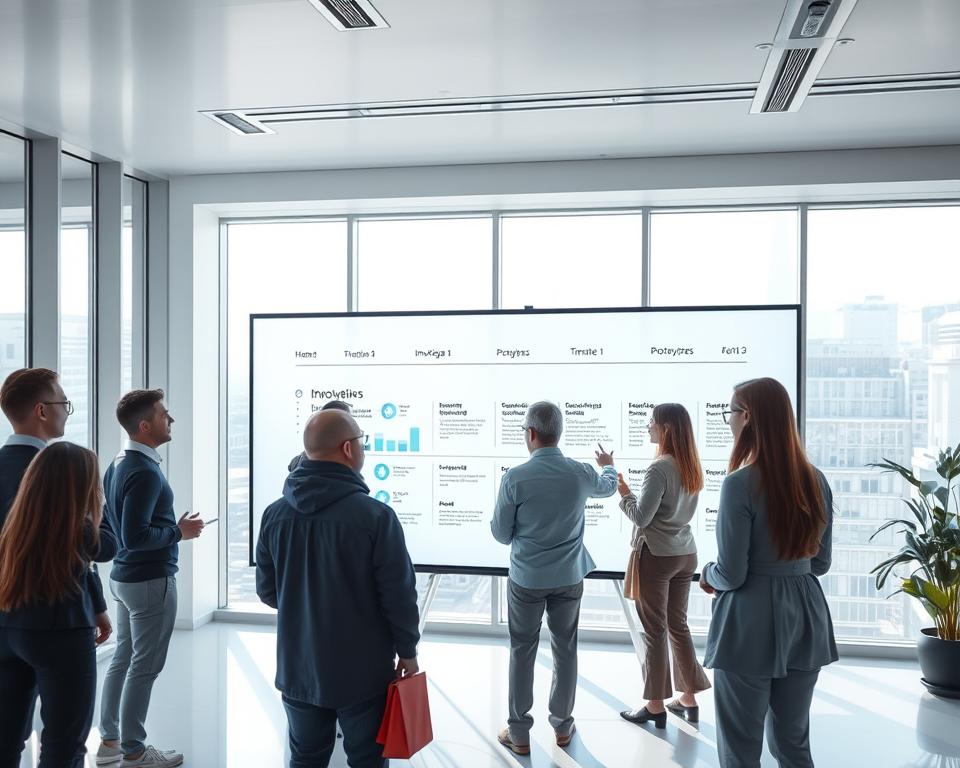Anúncios
strong. Are you ready to rethink how your company uses energy and meets climate goals?
In 2025, you face fast change across the United States. New green tech is shifting the energy transition and shaping corporate strategy and compliance now.
The intersection of energy systems, tech platforms, and sustainability programs can cut risk and lift performance across your industry.
These technologies deliver value when matched to clear goals, reliable data, and available resources rather than one-size-fits-all playbooks.
Leaders favor measurable impact, practical pilots, and credible frameworks over hype. You should too.
Anúncios
Use evidence, governance, and stakeholder alignment to turn ideas into results. For context on global market shifts and policy drivers, see a concise UN summary on frontier technologies and exports.
What you do next matters. Plan with data, align regulations, and run focused pilots so clean energy and related solutions fit your sector and your future needs.
Introduction: Why green tech innovation matters now in the United States
Renewable energy is moving from pilot projects into mainstream planning across U.S. companies in 2025.
Anúncios
Context and relevance in 2025: climate targets, market momentum, and corporate responsibility
Policy shifts and public pressure are pushing firms to act on climate change while markets reward practical energy solutions.
Since 1990, global CO₂ from fossil fuels and industry rose by over 60%, and the scale of change is why boards treat sustainability as material.
What counts as green tech today: from clean energy to circular systems and data-driven management
Green tech spans renewable energy, energy storage, circular-product strategies, and software platforms that improve transparency and traceability.
The IoT energy market alone grew fast, with forecasts showing a strong CAGR to 2025, signaling more data-driven tools for operations.
Innovation lens and your takeaway
Use strategy, measurable goals, and reliable data to pick pilots that match your risk appetite and regulatory needs in the U.S.
Align roadmaps to compliance, materiality, and stakeholder expectations. Consult qualified professionals and plan cross-functional pilots that track impact, emissions, and cost outcomes without promising guaranteed results.
The big list: green tech innovation trends transforming industries
Today’s market shows clear shifts: more wind and solar capacity is joining grids faster, and upgrades are making clean electricity integration more practical for your operations.
- Renewable energy expansion: Over 90% of new global capacity comes from wind and solar. By 2025 these sources may outproduce hydropower, and grid permitting reforms are speeding up connections.
- Energy storage breakthroughs: Solid-state, sodium-ion, gravity, and other systems offer varied duration and cost profiles to improve reliability and power availability.
- Smart grids and IoT: Sensors, AI, and predictive maintenance cut downtime and boost efficiency. The IoT-in-energy market is growing rapidly, enabling better consumption forecasts and safety.
- Circular economy strategies: Design-for-reuse, recycling programs, and material-efficiency choices reduce waste and help you lower production footprint across products and materials.
- Carbon capture, utilization, and storage (CCUS): CCU routes convert captured carbon into fuels, chemicals, or building materials, supported by simulation and project-planning software.
- Data-led sustainability: Carbon accounting, energy data platforms, and lifecycle assessment tools turn goals into measurable results and comparable outcomes.
- Hydrogen integration: Hydrogen can serve as long-duration storage and as combined heat-and-power in local systems for specific sector needs.
How to use this list: Treat these items as options to evaluate, not one-size-fits-all answers. Match systems and solutions to your sector priorities, weigh emissions and risk, and prioritize pilots where the technology is maturing.
Clean energy and storage: where cost, resilience, and emissions intersect
Energy storage is altering how you plan for uptime, price risk, and carbon outcomes. Markets and new chemistries give you options to match systems to real-world duty cycles.
Market signals: energy storage investment growth and diversified chemistries
The global energy storage market topped billions in value and is growing near a 9% CAGR through 2031. New chemistries — solid-state, lithium-sulfur, sodium-ion — plus gravity and salt options expand choices.
- Interpret growth: Investment trends show where storage supports clean energy integration and resilience.
- Match by need: Map chemistries to power duration, duty cycles, and operational risk before selecting systems.
Practical applications: battery management systems, EMS, and predictive analytics for uptime
Software matters. BMS, EMS, and predictive analytics increase efficiency and asset health by turning sensor data into actionable management routines.
- Use dispatch strategies tied to electricity price signals and emissions intensity.
- Plan siting, interconnection, and integration to avoid delays and hidden cost.
- Run targeted pilots with clear monitoring and reporting to validate cost savings and lifecycle impacts.
Do due diligence on vendors and maturity to manage lifecycle and carbon implications as you scale.
Smart grids, buildings, and demand innovation for lower consumption
Practical sensors and cloud platforms give you clear, real-time views of energy consumption across sites. You can spot waste, track equipment health, and set baselines before you act.

IoT in energy: remote monitoring, cloud analytics, and AI for demand response
IoT sensors, cloud analysis, and AI turn raw readings into useful data. The global IoT in energy market is growing fast, showing more options for remote monitoring and predictive maintenance.
Example: smart meters plus cloud analytics can detect failing motors and alert you before downtime, while AI-driven demand response shifts noncritical loads when electricity prices or emissions peak.
Building automation: cutting operating costs and improving certifications through smarter controls
Building automation coordinates HVAC, lighting, and access controls to boost efficiency and cut operating costs. That coordination also supports sustainability goals and certification efforts.
- Cybersecurity & systems management: ensure interoperability and secure connections.
- Baseline metering & KPIs: measure results and avoid overestimating cost savings.
- Change management: train staff and align facilities with sustainability and operations teams.
Run small pilots with clear KPIs and include tariff awareness, lifecycle maintenance planning, and vendor due diligence before scaling any green tech deployment.
Circular economy technologies reshaping products and supply chains
Shifting from linear production to looped systems helps you track materials and reduce disposal costs.
Tools that enable circularity: resource management, supply chain transparency, and waste optimization
Resource management software maps materials, parts, and finished products across suppliers and sites. You can see where resources sit, how often parts are reused, and which designs drive excess waste.
Supply chain transparency platforms verify sourcing, support recycling channels, and simplify regulatory disclosures. They make claims auditable and help you meet procurement rules for recycled content.
Waste analytics and optimization reduce disposal volumes and costs. These tools spot recovery opportunities, measure diversion rates, and guide reverse-logistics planning so you recover value from returns.
- Link production and purchasing workflows to environmental impact metrics and KPIs.
- Collaborate with suppliers on specs, recycled materials, and return rules.
- Run pilots on specific product lines to test repairs, reuse, and scalable returns.
Practical tip: document processes and testing so recycling and materials claims are auditable. Use clear governance and measurable goals to align your industry teams and protect quality, safety, and compliance.
Carbon management: tracking, capturing, and reusing emissions
Good carbon management starts with a clear baseline. Build that baseline using recognized frameworks and vetted activity data so your carbon footprint stands up to review.
From accounting to action: CCS simulation, offsets marketplaces, and LCA to guide decisions
Translate measured emissions into prioritized projects with transparent assumptions. Use lifecycle assessment (LCA) and CCS simulation to test options before committing capital to technologies.
- Baseline: map scopes, emission sources, and activity data against standards.
- Workflows: convert data into project proposals with clear metrics and timelines.
- Integrity: vet offsets, avoid double counting, and require third‑party verification.
Consider fossil fuels dependencies and transition pathways that match your climate and operational constraints. Run scenario analysis to weigh costs, risks, and benefits under different market conditions.
Software matters: carbon accounting platforms, CCS simulation tools, and offset marketplaces integrate with energy data to streamline reporting and tracking.
“Use governance, auditing, and cross‑team coordination so sustainability actions deliver measurable outcomes.”
For a policy perspective and strategy examples, review a national carbon management strategy.
Companies to watch: real examples powering the sustainable future
A handful of companies are proving practical models you can study and adapt for cleaner, more reliable energy and operations. These examples show how hardware, software, and service models combine to deliver measurable outcomes.
Hydromesh
What it does: Integrates hydrogen storage, combined heat and power (CHP), and AI to optimize local renewable use and long-term storage.
What you can learn: Study control strategies for pairing intermittent wind or solar with hydrogen storage and flexible power dispatch.
Planted
What it does: Provides a TÜV‑certified, GHG Protocol–aligned SaaS platform for carbon accounting and company-wide strategy.
What you can learn: Use certified frameworks to strengthen reporting credibility and link data to management actions.
Nextron
What it does: Offers energy-as-a-service in Brazil, connecting distributed solar to properties with consumption tracking and billing features.
What you can learn: Examine platform design that simplifies customer onboarding and metering integration.
ClimateLabs
What it does: Delivers consumer apps for personal carbon footprints and channels funding to verified projects.
What you can learn: Consider consumer engagement as a complement to corporate programs and project financing.
Faircado
What it does: An AI browser extension that finds secondhand alternatives across 1,600+ sites to extend product life and reduce waste.
What you can learn: Test reuse incentives and digital discovery tools to lower consumption and materials demand.
Arcadia
What it does: Provides community solar access and the Arc platform to organize energy data for carbon accounting.
What you can learn: Use organized energy data to tie customer-facing programs to measurable emissions outcomes.
“Look for patterns across company models—platforms, distributed power, and reuse markets—and test the pieces that match your regulatory and operational context.”
- Compare maturity, partnerships, and integration needs before piloting any solution.
- Plan metering, billing, and data flows early to avoid hidden costs.
- Adapt lessons from these companies to your sector rather than copying models wholesale.
How to choose a green tech software partner without overpromising results
Choosing a vendor is more than price — it’s about matching skills, systems, and governance to real goals. Start by defining clear objectives and the metrics you will use to judge pilots.
What to evaluate: domain expertise, portfolio relevance, scalable support, and cultural fit
Use a practical checklist to compare companies and reduce risk. Focus on evidence, not promises.
- Domain and portfolio: Confirm the company has real projects in your industry, ask for references, and review case studies.
- Development and architecture: Verify development practices, security posture, integration capabilities, and planned support so solutions scale responsibly.
- Governance and data: Require clear policies for data handling, access control, and compliance to protect stakeholders and resources.
- Cost and TCO: Compare upfront cost, total cost of ownership, and service levels. Watch for vendor lock‑in when evaluating technology choices.
- People and pilots: Assess cultural fit, communication norms, and escalation paths. Design pilots with objectives, metrics, and exit criteria, and secure training and change management budget.
Final step: pressure‑test contracts with legal, procurement, and independent experts before you commit. That keeps your sustainability program credible and your projects on track.
Conclusion
Practical choices in renewable energy and storage reshape how your operations meet reliability and climate goals.
Start with clear baselines and pilots that test wind, storage, and software under real conditions. Use metrics to track emissions, cost, and power reliability so you can judge results honestly.
Match technology and vendor choices to your sector, risk appetite, and resources. Consider products, materials, and waste across procurement and production, not just energy consumption.
Validate assumptions, track footprint trends, and iterate with governance. Engage qualified professionals for project design, legal reviews, and carbon reporting to keep actions credible.
Apply these ideas thoughtfully so your company builds a resilient, cost‑aware path toward a sustainable future without overpromising outcomes.



